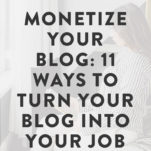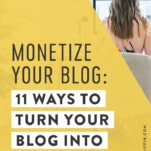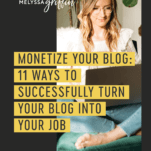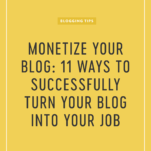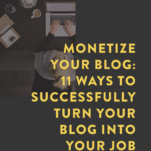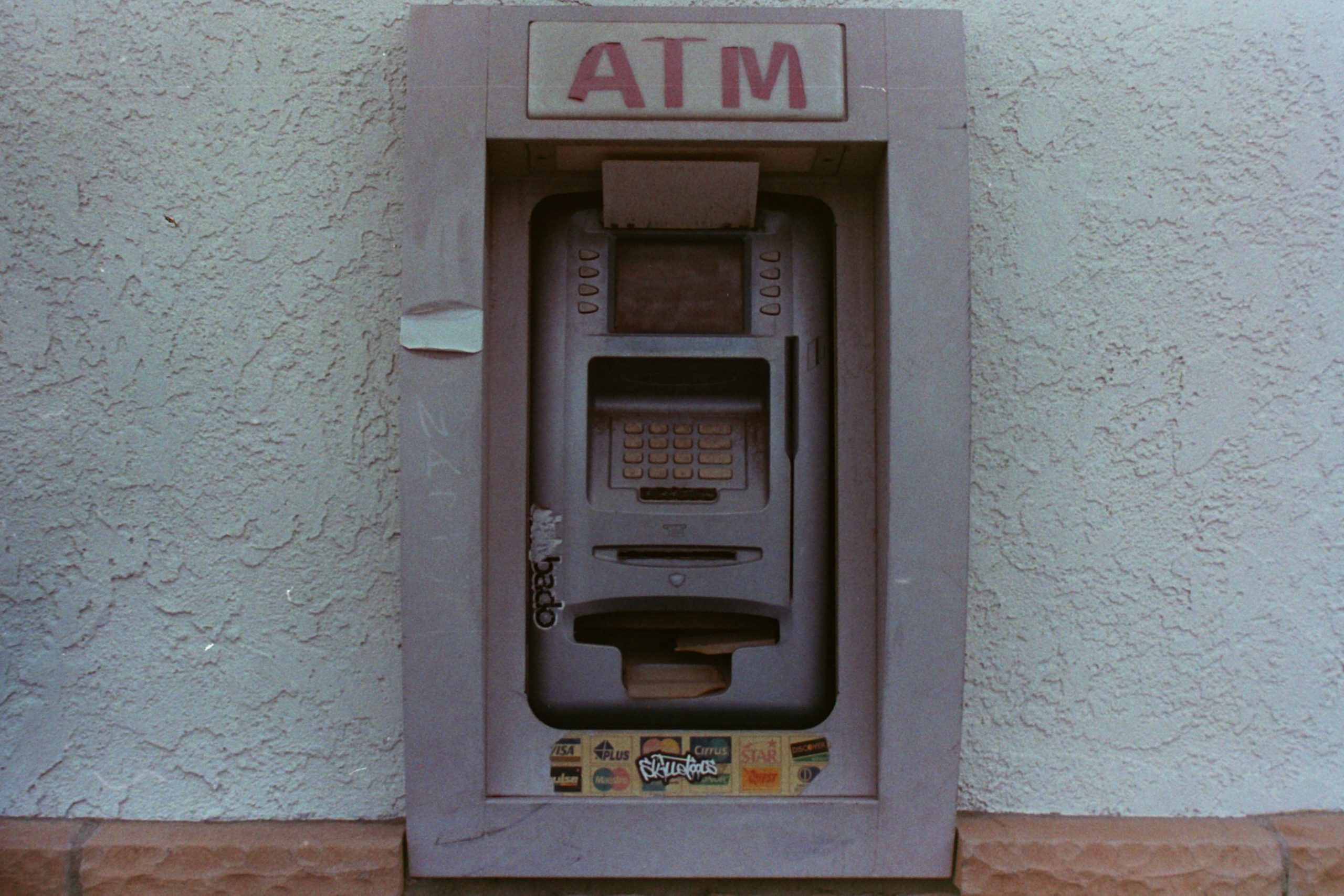So, you’ve started seeing your blog more. You spend late nights together at the computer and early mornings doing photoshoots of your coffee cup. You have the same interests, like to talk about the same things, and overall seem like a match made in Blogland. So, things are getting serious, buuut you have a few reservations about your “future” together. You love your blog and spend hours with it everyday, but after a few months or a year, you feel like your blog could contribute more to your relationship. I mean, you pay all the bills and work a day job on the side…can’t your blog do anything, too?
Actually, yes. It totally can.
And consider this post your “blog relationship therapy session” for the year, because I’m about to show you how your blog can work for you, instead of being that moochy roommate who eats all your chips.
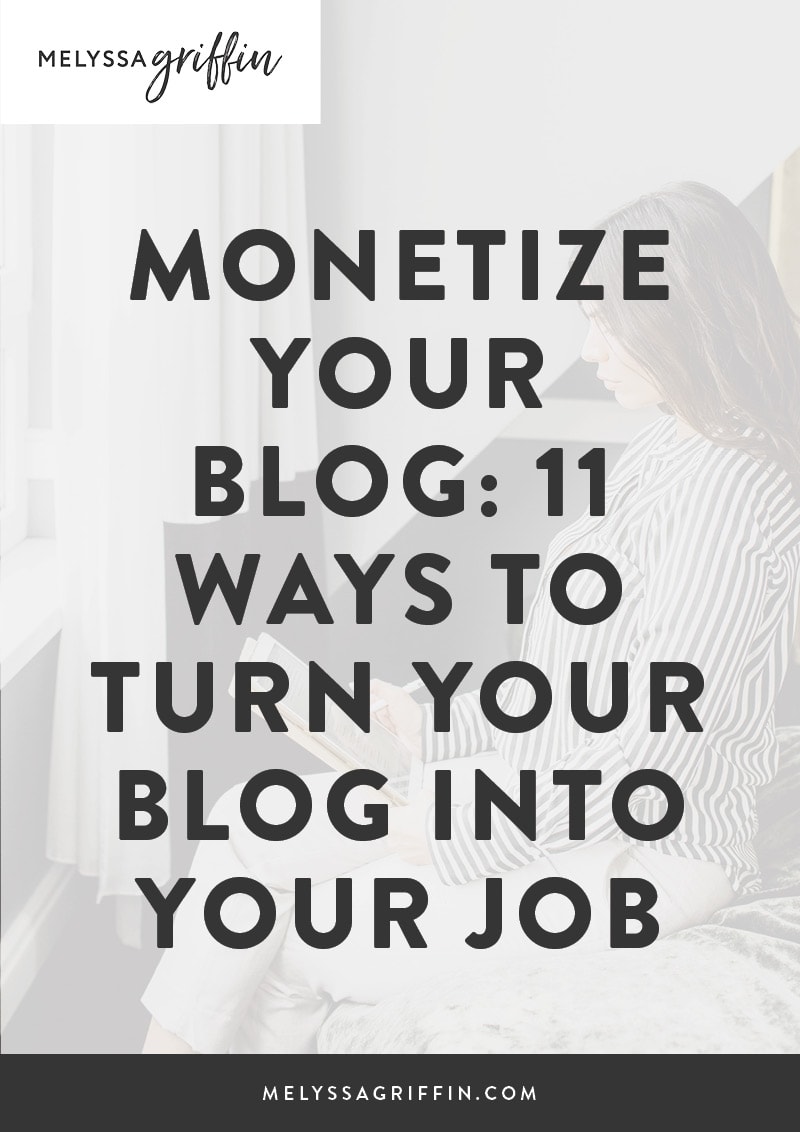
So, in case you’ve ever wanted to successfully monetize your blog, but worried that it would take years and years, then I’ve got news for you, my friend. 😉 Many of these strategies can start working for you in the next 30 days. In fact, I’m sharing eleven different ways that you can earn an income from your blog (including two that I don’t think you should waste your time on). So let’s get started already, shall we?
First of all, there are three different “types” of blog income. Generally, the income you earn from your blog would fall under one of these areas:
- Promoting other people’s stuff
- Running a service-based business
- Creating and promoting your own stuff
Below, I’m explaining each of these in detail and also sharing several specific ways that you can utilize them and start earning some moo-lah. Awww yeahhh.
Promoting other people’s stuff
First up is promoting other people’s products. In this revenue stream, you are using your blog as a way to promote products that other people or brands create. This is usually what people think of when they think about “earning money as a blogger.” But nowadays, things are changing. It’s certainly still possible to earn a full-time income by promoting other people’s products, but there are newer, more profitable ways to grow your bank account as a blogger, which we’ll talk about later on in this post. But first, let’s dive in here!
1. Ads
The most basic way to earn money as a blogger is by putting ads on your blog. Also? It’s one of the worst ways.
Yeah, I just went there.
I say this for two reasons:
- You’re growing someone else’s brand. When you layer your blog with advertisements, you’re essentially growing your traffic and audience…just to help someone else grow their own brand instead. When you think of it that way, doesn’t it sound kind of crazy to use ads as a way to monetize your blog?
- They’re not very profitable unless you have an enormous following. I used to use ads on my blog to earn some extra money. But get this: the most I ever earned in a single month from ads was $400 and that was when I had about 200,000 monthly pageviews. It took me years to grow my blog to such traffic, and my paycheck was barely enough to cover my monthly car payment. *shakes fist* Bonkers, right? So, think about it…is it worth it to spend years growing your blog, just to earn the bare minimum? Or are there other options (hint: in this article!) that would do you better?
So, as you can see, I’m not really a fan of ads. Not only are they ineffective at growing your income, but they also take away from your own brand that you’ve worked so hard to build.
Side note: At the time of writing this, I do have one ad on my site. The reason being that I signed a contract with a certain ad network and now have to keep an ad up on my site until the contract expires. So let that be another reminder that ads reduce how much control you have…over your own website!
2. Brand Sponsorships + Sponsored Posts
Next up is working with brands on collaborations, such as sponsored posts. I’ve done my fair share of sponsored posts in the past, sometimes earning things like free computers or $800 paychecks. Even still? I don’t think sponsored posts are worth it. Again, there are better ways to earn a paycheck than focusing on promoting other people’s products.
Is the occasional, once-a-quarter sponsored post okay? Sure! You can use it as supplemental income if it’s with a brand you and your readers absolutely adore, but I would not recommend making this your #1 source of income.
Also, here’s a little story for you about one brand I once pitched to work with. I emailed this brand because I really loved them and had a collaboration idea that we could do together. When they responded to my initial email, I noticed an email that was accidentally forwarded to me in the email thread — something that was just between two members of the brand’s PR department:

Ouch. Seeing that emailed confirmed something important to me: working with brands can oftentimes be about the numbers you project, not the impact you have on people. Ever since I stopped taking on sponsored posts, I’ve felt so much better about my blog. I don’t care as much about the “numbers” because they don’t matter to anyone else but me. Now, I care about the people I get to help and the fun projects I create. #freedom.
If you’re still dead set on doing sponsored posts, here’s a guide to help you out: How to Work With Brands as a Blogger
3. Affiliate programs
Out of all the “promoting other people’s stuff” options, I’ve found the most success with affiliate programs. Here are a few reasons why I prefer using affiliate programs over ads or brand sponsorships:
- They can have a very large, recurring payoff. One company that I’m an affiliate for typically pays me $3,000-$5,000 per month for my affiliate commission.
- It requires very little work. One of the keys to using affiliate programs is to write an affiliate blog post that gets traffic each day. If you’re using SEO, then your post will naturally get more and more traffic over time. So, your only work is to write one affiliate blog post, which can lead to big payouts. It is truly “passive income.”
Now, here’s the one downside of affiliate programs: your income is still reliant on someone else. It’s not as stable as other income streams, like creating and selling your own products. It’s also not uncommon to have a really big month, followed by a month of tiny commissions. So, using affiliate programs can be awesome if you’re using them strategically, but they shouldn’t be your only source of income.
Related: My Complete Strategy for Writing Highly Profitable Affiliate Post (Free Worksheet!)
Running a service-based business
When I first started to earn a solid income from my blog, it was because I started my own service-based business as a web designer. As a blogger, you spend a lot of time creating content and growing a targeted audience. That is the perfect foundation to launch a business from. In my experience, I started earning a full-time income from my part-time service-based business in about three months. By my second year of business, I was consistently having $10,000 months as a web designer.
It’s entirely possible to run a thriving, heart-centered service-based business through your blog. This is an instance where you’re promoting your services, rather than someone else’s, so it all contributes to your overall brand. Ultimately, I decided to close up shop for my web design studio after two years because I was getting burnt out on working with clients and doing the same types of things (designing websites) day after day. I needed to shake up my routine and also reclaim some freedom for myself, since having clients was sometimes reminiscent of having a boss.
Also, one of the biggest downsides of running a service-based business is that it’s not scalable. This means that if you spend 10 hours working with one client, then you’ll only ever be paid for 10 hours of work, right? But if you create your own products and sell them (discussed in the sections below!), you could spend 10 hours working on a product and then sell it over and over again to hundreds of people. There’s no limit.
I know that some people love having clients, so it’s up to you to decide what you prefer. I enjoyed it at first, but decided to move on to e-courses and workshops instead because of all of the points I mentioned above. I have absolutely no regrets…in fact, I wish I’d started selling e-products sooner!
If you’re interested in one-on-one work, here are a couple options for you if you’re thinking of starting a service-based business through your blog:
1. Coaching or Consulting
Being a Coach or Consultant has been growing in popularity. Essentially, if you have knowledge or a skill that people want, then you can work with them, one-on-one, to make it happen. If this sounds interesting to you, then you need to be incredibly clear with yourself on who your ideal client is and exactly where they’ll be after you coach with them. What’s the goal?
While growing my web design business, I also worked as a Blog Consultant/Coach because I noticed that people were coming to me for advice about the same things and I had a feeling I could turn my experience into a coaching program. I didn’t do as much coaching as designing because I had too many design clients to handle, but did really enjoy my time with coaching clients.
Do people constantly ask you the same things again and again? Do you feel like you’ve set up a strong process or strategy to get from one place to another? Then you might be on the right track to create a coaching business! However, keep in mind that being a coach isn’t really scalable and you’re still essentially trading your time for money.
2. Other services in your field
Other service-based jobs could include being a graphic designer, copywriter, SEO specialist, or any specific service that your audience may need. Basically, if you have a skill that you can use in order to help people, then you can probably turn it into a service-based business.
3. Speaking at events

Speaking at events can be a lucrative way to build your brand and authority. Initially, I put this option under the “creating and promoting your own stuff” section, but the more I thought about it, the more I realized that speaking at events is very similar to a service-based business. Like service businesses, you’re trading your time for money and working with clients (event planners).
The potential downside to launching a speaking career is that you will need to build up an audience and reputation before you can really expect to receive high-paying speaking gigs. Sounds a lot like what you need for ads and brand sponsorships, right? But if you love public speaking, sharing your knowledge, and interacting with new people, this might be something that you could fall in love with.
Overall, launching a service-based business through your blog is certainly one way to earn an income and can absolutely evolve into your full-time business. But just keep in mind that if you’re trying to escape a “day job” because you want more freedom, then working one-on-one with clients may actually not be all that different.
And now for my favorite way to earn a living as a blogger…
Creating and promoting your own stuff
Ahhh giggity. I saved the best for last. I’ve tried each of my three different ways to earn an income as a blogger and can say with confidence that creating and promoting my own products has been my favorite way to monetize my blog. Not only do I have complete freedom over my business, but I also feel like I am helping and connecting with TONS more people than I was able to do when I promoted other people’s products or ran a service business. My income has grown rapidly, too. I really do believe that creating your own products is the future of blogging.
With that said, here are a few ways that you can monetize your blog with your own e-products.
1. E-courses
I launched my first e-course about two years ago, in my very first year of blogging. My audience was still small, I didn’t even have an email list, and I had never heard of a webinar, yet I was still able to bring in about $4,000, which certainly felt enormous to me at the time!
Now, my business is built upon e-courses and workshops and I absolutely love it! I’ve found that creating my own e-products has given me freedom, allowed me to help way more people, and has increased my income like gangbusters. In fact, because of e-products, I had my first $30,000 month, which is closer to what I used to earn from my day job in a year than anything I’d ever earn in a month.
E-courses are scalable (meaning you create one product and can sell it again and again) and I really enjoy the teaching and marketing aspects. I also believe that just about anyone can create an e-course based on your skills, knowledge, or experience with something.
The only downside to e-courses is that they take a lot of up front commitment and dedication to launch. It’s no easy task to create an eight-module e-course without a deadline or boss hovering over you. Also, if you’re not careful with your marketing strategies, it’s possible to burn out and feel overworked by this “passive income” stream. That’s why it’s so important to have the right systems and strategies in place.
2. Online workshops
An online workshop is very similar to an e-course, but is initially delivered live and therefore isn’t divided up into modules as precisely as an e-course is. It also may not come with quite as many bells and whistles as an e-course would and is the perfect medium for new-to-info-product bloggers who want to earn serious money selling digital products without a huge commitment, like creating an entire course.
So how does it work? With an online workshop, you pre-sell your class before it starts. That means that there is an element of scarcity built into this income method, because people know that if they don’t sign up by the deadline, they won’t get to see you live. No other method has that same, powerful level of scarcity.
Also, creating a 2-3 hour workshop takes a whole lot less time than it would to create an e-course, so it feels less daunting for people who want to start creating e-products, but have a crazy schedule. In fact, when I launched my first paid workshop, I planned and created all of the materials in about two days. Two days! It’s very doable.
The awesomest thing about creating an online workshop? Once your class is finished and recorded, you will be able to package those videos into a higher-priced course and sell them over and over again! So essentially, you just recorded an e-course in one day. Sweet, right? Online workshops are what I recommend to any blogger who is starting to dive into the realm of e-products and wants to earn a full-time income from their blog.
3. E-books or self-published books
Creating your own e-books or physical books is a solid way to earn an income through your blog, especially if you prefer writing to speaking. I personally haven’t published any e-books or self-published books because I enjoy the community aspect of e-courses more. Also, consider that it may take you the same amount of time to create an e-book as it would to create an e-course, yet, e-books often sell for ten times less than e-courses. Say whaaaat?
Think of it this way: If you spend 40 hours creating an e-book, but only get 5 sales at $10 each, then you just spent 40 hours to earn $50. Ouch. But if you spent the same amount of time to create an e-course or workshop, still only made 5 sales, but priced it at $247, then you’d make $1,235. Big difference, right?
E-books can be a good form of supplemental income, but if you’re diving into e-products and really want to turn your blog into your full-time job in less than a year, then I’d suggest going with a workshop or e-course instead.
4. Membership site
A membership site is when your subscribers pay a monthly fee to access some sort of “member’s only portal.” Typically, you would update the site every 2-4 weeks with new materials for your subscribers to watch, read, or download. Membership sites can work well for just about any niche out there and are a great way to have monthly recurring revenue.
The reason I haven’t launched any membership programs is the same reason that many other people choose not to: because having a monthly deadline to create new content indefinitely doesn’t sound too sexy. Membership sites certainly work for some people who are willing to maintain the site and consistently add new content each month, but it’s an endeavor I wouldn’t suggest getting into unless you’re certain that you are able to keep it up.
5. Physical Products
Lastly, many bloggers earn a living by selling their own physical products, which can range from yearly planners to high-end clothing lines. Launching physical products is a great way to build awareness of your brand and can be a lucrative method. However, physical products have the largest up-front fees, so it can be expensive to start a business like this one.
In my second year of blogging, I launched a print and greeting card shop on Etsy. The shop grew much more slowly than the other businesses I had started before it and was also costly, since I had to invest in a professional printer (which is now buried in my closet) and plenty of packaging and shipping supplies. Even though I thought that having my own physical products and prints was my “dream,” I quickly got burnt out and didn’t like having to pack and ship each order myself.
Overall, physical products can work if you’re willing to invest in your business at the start and stick through the miscellaneous details, like shipping and inventory.
With ALL that said, I hope this post gave you a solid overview of the different ways to truly monetize your blog. As you can probably tell, my favorite monetization methods are e-courses and online workshops because they are scalable, require low up-front investments, allow you to connect with more people, and effectively grow your brand. They’re kind of the shiz, in case you were wondering. 😉

